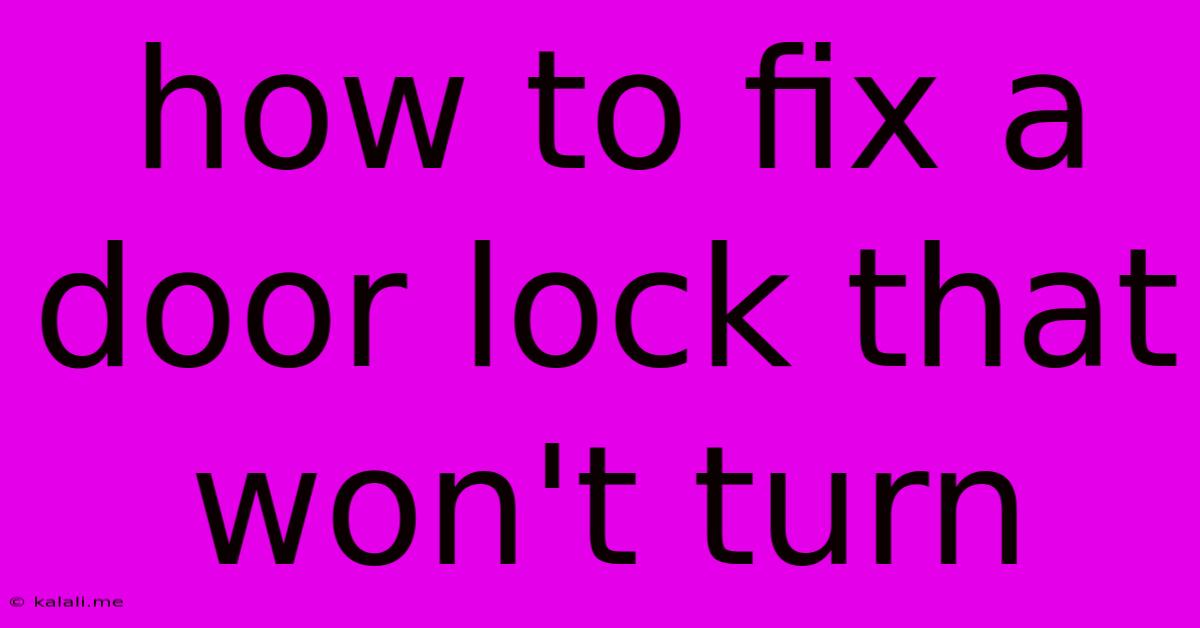How To Fix A Door Lock That Won't Turn
Kalali
May 22, 2025 · 3 min read

Table of Contents
How to Fix a Door Lock That Won't Turn: A Troubleshooting Guide
A door lock that refuses to turn is a frustrating problem, leaving you feeling vulnerable and inconvenienced. This comprehensive guide will walk you through troubleshooting and fixing common causes of a stubborn door lock, from simple solutions you can try yourself to when you might need to call a locksmith. This article covers everything from identifying the problem to preventative maintenance to keep your lock working smoothly.
Understanding the Problem: Why Won't My Door Lock Turn?
Before diving into solutions, it's crucial to understand why your door lock isn't turning. Several factors could be at play, including:
- Broken or jammed internal components: This is a common culprit, especially in older locks. Worn-out springs, broken tumblers, or seized mechanisms can all prevent the lock from turning.
- Stuck bolt: The bolt itself might be jammed, either due to debris, paint, or warping of the door or frame.
- Key issues: A bent, broken, or worn-out key can fail to engage properly with the lock mechanism.
- Improper key alignment: The key might not be fully inserted or aligned correctly in the keyhole.
- External damage: Forced entry attempts or damage to the lock casing can lead to malfunction.
Troubleshooting Steps: DIY Solutions
Let's tackle some straightforward fixes you can attempt before calling a professional:
1. Check the Obvious:
- Lubricate the lock: Apply a few drops of graphite-based lubricant (not WD-40, as it can attract dust and debris) into the keyhole. Work the key gently back and forth to distribute the lubricant. This can help free up stuck mechanisms.
- Inspect the key: Examine your key carefully for any bends, breaks, or excessive wear. A damaged key is a common cause of lock failure.
- Check for obstructions: Carefully inspect the keyhole for any debris, dust, or paint that might be hindering the key's movement. Use compressed air or a small, soft brush to remove any obstructions.
- Ensure proper key insertion: Make sure you're inserting the key fully and straight into the keyhole. A slightly misaligned key can prevent it from turning.
2. Address Stuck Bolts:
- Inspect the bolt: Check if the bolt is sticking or binding in the strike plate. Gently try to move the bolt manually. If it's stuck, you might need to adjust the strike plate or address warping issues.
- Check the door alignment: A misaligned door can put pressure on the bolt, preventing it from moving smoothly. Look for any gaps or inconsistencies between the door and the frame. Minor adjustments might be possible with shims.
3. More Advanced Troubleshooting:
- Remove the door handle: This will allow you to inspect the internal mechanisms more closely and identify broken parts. Refer to your door handle's instruction manual or find online videos demonstrating the disassembly process. Be careful and take note of the order of disassembly.
- Inspect internal components: Look for any broken springs, jammed tumblers, or other damaged parts. Replacing these components may be possible, depending on your level of experience.
When to Call a Locksmith:
If you've exhausted the above troubleshooting steps and your door lock still won't turn, it's time to call a qualified locksmith. Attempting complex repairs without the necessary knowledge and tools can cause further damage. A locksmith possesses the expertise and tools to diagnose and fix more intricate lock problems efficiently and safely. This is particularly important if you suspect serious damage or security compromises.
Preventative Maintenance: Keeping Your Locks in Top Shape
Regular preventative maintenance is key to avoiding future lock issues. This includes:
- Periodic lubrication: Lubricate your locks at least once or twice a year.
- Regular inspection: Periodically inspect your locks for any signs of wear, damage, or obstructions.
- Avoid forcing the key: Never force your key if it doesn't turn smoothly. This can damage the lock mechanisms.
By following these steps and understanding when to seek professional help, you can effectively troubleshoot and resolve most door lock problems, ensuring the security and functionality of your home. Remember, safety is paramount, and don't hesitate to call a locksmith if you're unsure about any repair process.
Latest Posts
Latest Posts
-
How Do You Switch Off Iphone 7
May 22, 2025
-
Getting Rid Of Mold On Bathroom Ceiling
May 22, 2025
-
Beer In The Freezer How Long
May 22, 2025
-
The Rabbit Is Out Of The Hat
May 22, 2025
-
French Movies With English And French Subtitles
May 22, 2025
Related Post
Thank you for visiting our website which covers about How To Fix A Door Lock That Won't Turn . We hope the information provided has been useful to you. Feel free to contact us if you have any questions or need further assistance. See you next time and don't miss to bookmark.